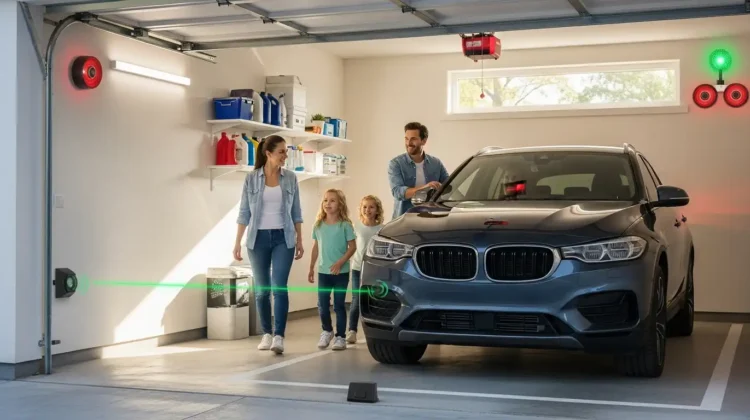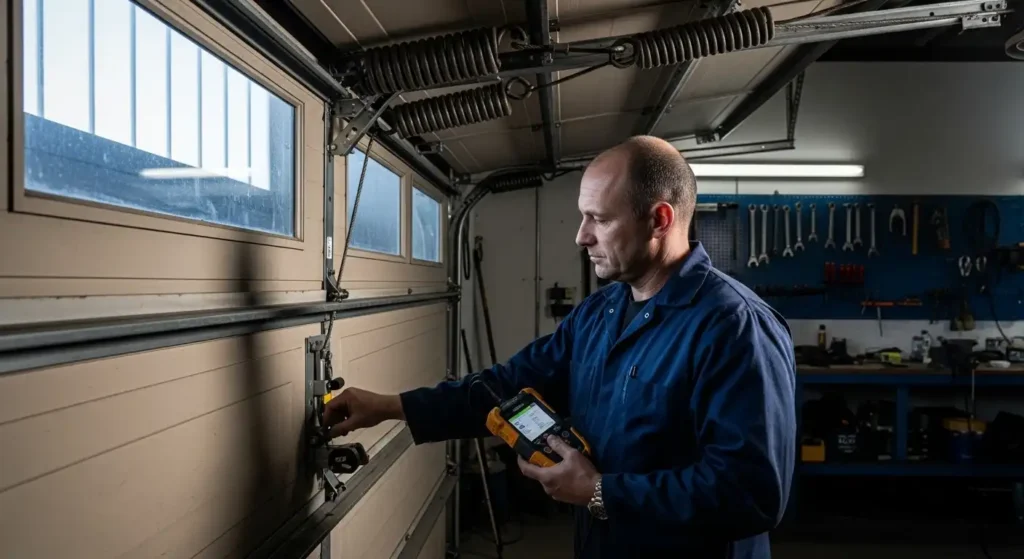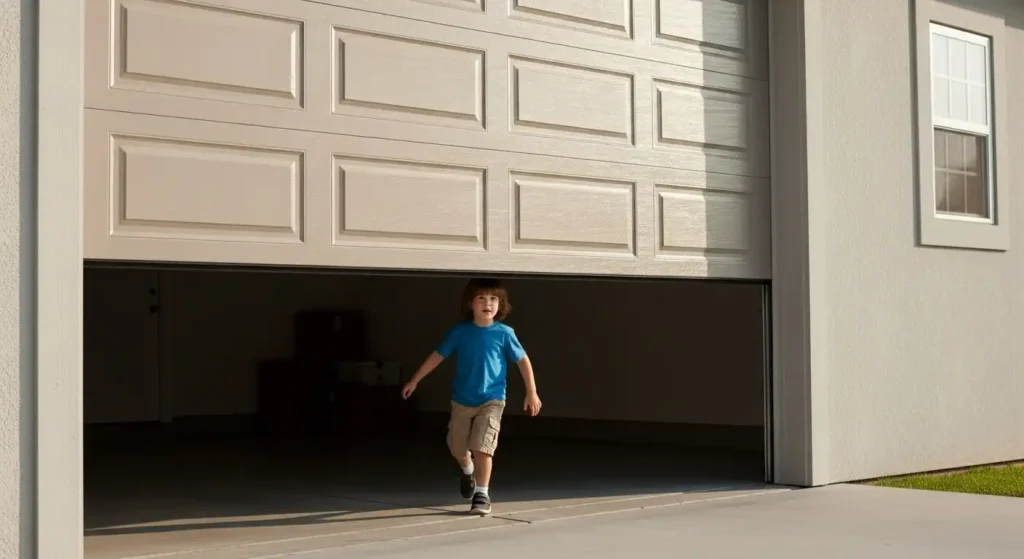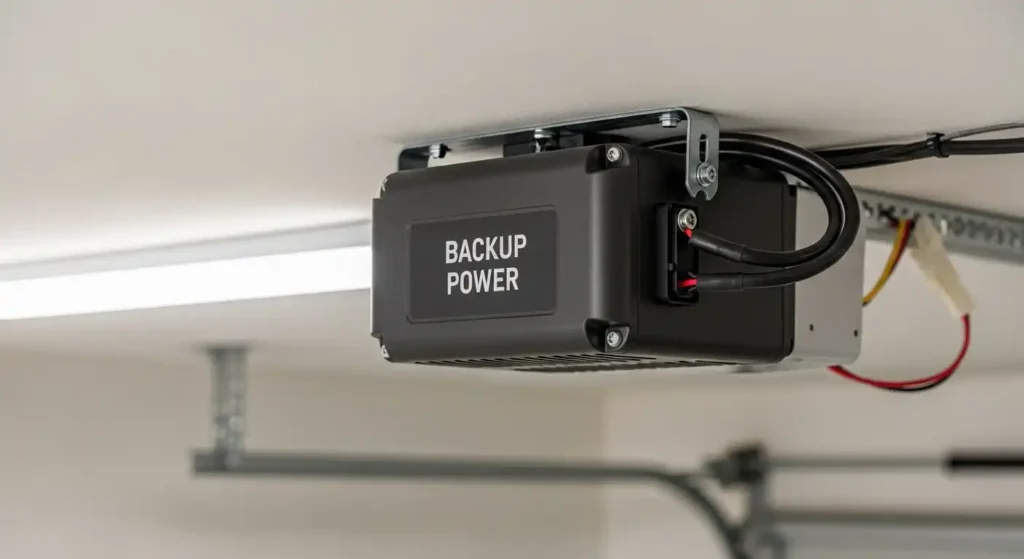
Garage doors are no longer just mechanical panels that open and close — they now include advanced safety technologies that protect your family, property, and deliveries. In 2025, homeowners have more ways than ever to improve security through smart automation, motion sensors, and built-in safety systems. This guide explains the most essential garage door safety features you should know and how keeping your system updated enhances your home’s safety.
Why Garage Door Safety Matters

Garage doors weigh hundreds of pounds and move several times each day. Without proper safety mechanisms, accidents can happen quickly. The U.S. Consumer Product Safety Commission reports thousands of garage door-related injuries every year — many involving children or pets. Thankfully, modern garage doors include multiple features that help prevent these accidents before they occur.
Consistent maintenance keeps these features working as intended. Therefore, regular inspections and timely upgrades can drastically reduce risks. For step-by-step maintenance advice, see our post on regular garage door inspections.
1. Auto-Reverse Mechanism
The auto-reverse mechanism remains one of the most important safety innovations ever created for garage doors. When the door touches an obstruction — such as a person, pet, or object — it immediately reverses direction to prevent injury or damage.
- How it works: Sensors detect resistance as the door lowers and send an instant signal to lift again.
- Why it matters: It prevents crushing injuries and protects your belongings.
- Maintenance tip: Test this feature monthly. Simply place a soft object, like a roll of paper towels, under the door; it should reverse as soon as it touches it.
2. Photoelectric Safety Sensors

Photoelectric sensors sit a few inches above the floor and project an invisible beam across the garage door opening. If anything interrupts that beam, the door stops and reverses direction immediately.
- Purpose: Detects people, pets, or objects in the doorway before closing.
- Common issues: Misalignment, dust buildup, or loose wiring may interrupt function.
- Quick fix: Clean the lenses and align the sensors until their indicator lights are solid.
These sensors became mandatory for all new automatic openers after 1993. As a result, they remain one of the simplest and most reliable ways to prevent accidents in modern homes.
3. Manual Release Handle
During a power outage or system malfunction, you can still operate the door manually using the release handle. This safety feature ensures you never get trapped inside or outside your garage.
- Why it’s important: It provides an emergency exit option when the power goes out.
- Safety tip: Show everyone in your household how to use it safely. Most handles are red and located near the opener rail.
Never pull the handle while the door is open; it can fall rapidly. Instead, perform this action only when the door is fully closed. For ongoing reliability, add this check to your seasonal maintenance routine.
4. Motion Detection and Lighting Systems
Many garage door openers now include motion sensors that automatically turn on lights when movement is detected. This feature increases both safety and convenience, especially at night.
- Advantages: Enhances visibility, deters intruders, and helps you navigate safely in the dark.
- Smart integration: Some systems connect to home automation hubs to trigger cameras or send smartphone alerts when motion occurs.
In addition, well-lit garages reduce tripping hazards and improve security, making this a worthwhile upgrade for most homeowners.
5. Rolling Code Technology
Older garage door openers used fixed radio codes, which thieves could easily intercept. Rolling code technology prevents this by generating a new security code each time you press the remote button.
- Benefit: Protects against code grabbing and unauthorized entry.
- Compatibility: Most brands now include this feature, including LiftMaster, Chamberlain, and Genie.
Therefore, upgrading to a modern opener equipped with rolling code security significantly strengthens your home’s protection.
6. Smart Garage Door Control Systems
Smart garage door systems combine technology and convenience. Using a smartphone app, you can monitor door activity, receive alerts, and even close your door remotely if you forget.
- Top feature: Remote access from anywhere, offering peace of mind when you’re away.
- Added security: Geofencing automatically closes your door once you leave the area.
To explore smart automation in more detail, visit our article on how smart garage doors are transforming home security.
7. Pinch-Resistant Door Panels
Pinch-resistant panels prevent fingers from getting caught between door sections. This feature is particularly valuable for households with children or elderly family members.
- How it works: The design forces panels apart slightly as they move, keeping hands safely away.
- Extra benefit: Many pinch-resistant doors also include improved insulation and soundproofing.
8. Battery Backup Systems

Power failures can happen unexpectedly, but battery backup systems keep your garage door operational when electricity goes out.
- How it helps: Ensures you can open or close the door during blackouts or storms.
- Maintenance tip: Replace backup batteries every 2–3 years for consistent performance.
Moreover, this feature is essential for homeowners in regions prone to severe weather or frequent outages.
9. Force Settings and Auto-Lock Systems
Force settings control how much power the opener uses to lift or close the door. When adjusted correctly, they prevent the door from slamming down or damaging the motor.
- Auto-lock option: High-end openers automatically lock after closing, adding another layer of protection.
- Recommendation: Contact a professional if your door jerks or moves unevenly. Incorrect settings can strain components.
10. Garage Door Edge Sensors
Edge sensors are an additional safety measure installed at the bottom of the garage door. They detect contact pressure and immediately signal the door to reverse direction.
Although less common in homes than in commercial buildings, they are highly effective for garages with frequent traffic or heavy use. In combination with photoelectric sensors, they offer the highest level of safety protection available today.
Regular Testing and Maintenance
Even the most advanced features require routine care. Dust, wear, and misalignment can cause safety systems to fail over time. As a result, you should perform monthly tests and schedule professional service at least once a year. For a full checklist, review our seasonal garage door maintenance guide.
Future Innovations in Garage Door Safety
Looking ahead, garage door safety technology continues to evolve. Manufacturers are developing AI-powered predictive maintenance, biometric entry systems, and enhanced anti-tamper locks. Consequently, future garage doors will not only prevent accidents but also detect and respond to potential threats automatically.
Final Thoughts
Today’s garage door safety features combine mechanical reliability with smart innovation. By understanding these key systems — auto-reverse, photo sensors, rolling codes, and more — you can protect your family and home with confidence. In addition, maintaining these features regularly ensures they continue to perform effectively for years to come.
For more expert tips on keeping your garage safe, visit our GarageDoor.Club safety archive.
